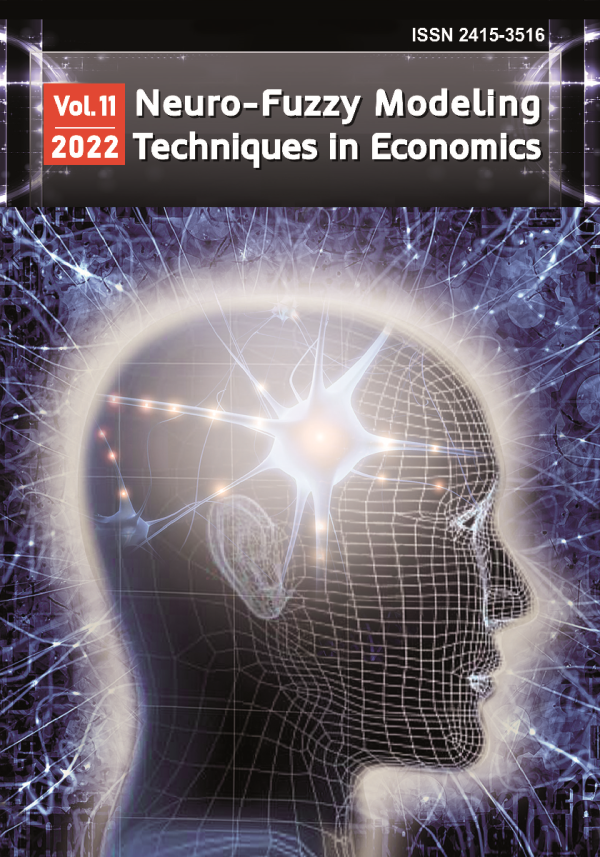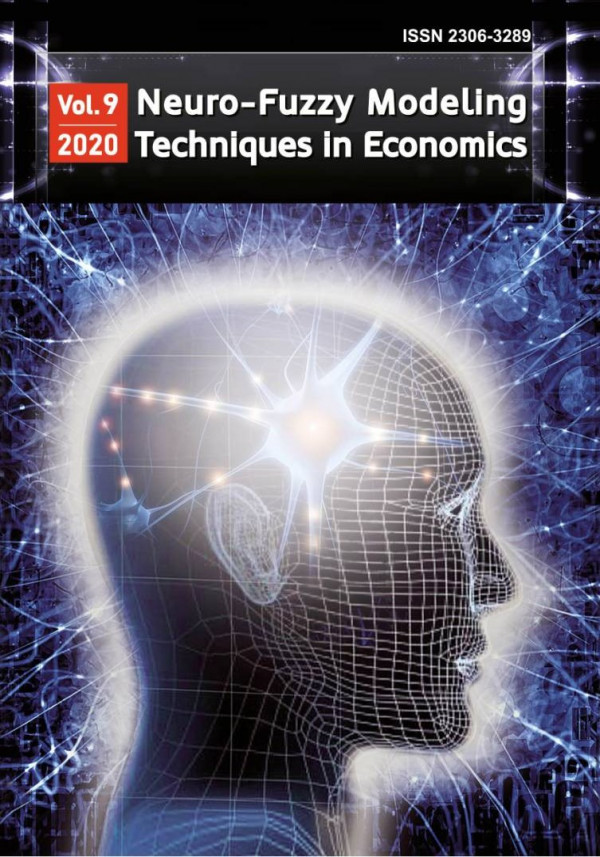
Neuro-Fuzzy Modeling Techniques in Economics
ISSN 2415-3516
Прогнозування вилову риби і морепродуктів у глобальній економіці
Forecasting the fish and seafood catch in the global economy
DOI:
10.33111/nfmte.2020.175
Анотація: В статті запропоновано новий науковий підхід до прогнозування вилову риби та морепродуктів, що ґрунтується на застосуванні математичного апарату нейронних мереж (а саме, карт самоорганізації Кохонена) та економетричних моделей (авторегресійних функцій). Карти самоорганізації надали можливість здійснити кластеризацію країн світу за показниками вилову риби та морепродуктів, що дозволило визначити групи країн та територій, стан та розвиток рибного сектору яких є подібними між собою. Зважаючи на надто різнорідний стан цієї галузі за різними країнами процедуру кластеризації довелось здійснити повторно ще в рамках окремих груп країн. Після отримання однорідної вибірки для вирішення задачі прогнозування обсягів вилову риби та морепродуктів запропоновано застосувати моделі регресії часових рядів. В ході ряду експериментів було визначено найкращу прогностичну модель з порядком авторегресії AR(5). Отриманий прогноз та показники якості моделі вказують на доцільність застосування запропонованого кількарівневого підходу до побудови прогнозних моделей, що ґрунтується на кластеризації країн світу та формуванні однорідних навчальних вибірок. Подібний підхід може бути використаний у широкому спектрі економічних та управлінських задач.
Abstract: The article proposes a new scientific approach to forecasting the catch of fish and seafood, based on the use of the mathematical apparatus of neural networks (namely, Kohonen self-organizing maps) and econometric models (autoregressive functions). Self-organizing maps provided an opportunity to cluster the countries of the world according to the indicators of fish and seafood catch, which made it possible to identify countries and areas whose state and development of the fisheries sector are similar to each other. Due to the too heterogeneous state of this industry in different countries, the clustering procedure had to be repeated even within certain groups of countries. After obtaining a homogeneous sampling to solve the problem of predicting the volume of fish and seafood catches, it is proposed to apply time series regression models. Through a series of experiments, fifth-order autoregression AR(5) was determined as the best predictive model. The forecast obtained and model quality indicators approve the feasibility of applying the proposed multi-level approach to building predictive models, which is based on the clustering of countries of the world and the formation of homogeneous training samples. A similar approach can be used in a wide range of economic and managerial tasks.
Ключові слова: рибальство, кластеризація, прогнозування, карта самоорганізації, нейронна мережа, авторегресія
Key words: fish catches, clustering, forecasting, self-organizing map, neural network, autoregression
УДК: 339.977:639.2
UDC: 339.977:639.2
JEL: C38 E27 Q22
To cite paper
In APA style
Chuzhykov, V., Miroshnychenko, I., & Lukianenko, O. (2020). Forecasting the fish and seafood catch in the global economy. Neuro-Fuzzy Modeling Techniques in Economics, 9, 175-197. http://doi.org/10.33111/nfmte.2020.175
In MON style
Чужиков В.І., Мірошниченко І.В., Лук’яненко О.Д. Прогнозування вилову риби і морепродуктів у глобальній економіці. Нейро-нечіткі технології моделювання в економіці. 2020. № 9. С. 175-197. http://doi.org/10.33111/nfmte.2020.175 (дата звернення: 17.12.2025).
With transliteration
Chuzhykov, V., Miroshnychenko, I., Lukianenko, O. (2020) Prohnozuvannia vylovu ryby i moreproduktiv u hlobalnii ekonomitsi [Forecasting the fish and seafood catch in the global economy]. Neuro-Fuzzy Modeling Techniques in Economics, no. 9. pp. 175-197. http://doi.org/10.33111/nfmte.2020.175 [in Ukrainian] (accessed 17 Dec 2025).
 # 9 / 2020
# 9 / 2020
Download Paper
659
Views
152
Downloads
0
Cited by
- Aoki, I., Yamakawa, T., & Takasuka, A. (2018). Fish Population Dynamics, Monitoring, and Management. Sustainable Fisheries in the Eternal Ocean. Springer. https://doi.org/10.1007/978-4-431-56621-2
- Marino, M. (2011). Fisheries Management in Japan. Its institution features and case studies. Springer. https://doi.org/10.1007/978-94-007-1777-0
- Anderson, L. G. (2004). The Economics of Fisheries Management (2nd revised ed.). The Blackburn Press. https://doi.org/10.1111/j.0022-1112.2005.0751a.x
- Engle, C. (2020). Aquaculture Businesses: A Practical Guide to Economics and Marketing. 5m Books. https://www.perlego.com/book/2014517/aquaculture-businesses-a-practical-guide-to-economics-and-marketing-pdf
- Ozyurt, R. (2013). Socio-Economic Status of Small Scale / Artisanal Fisheries in Middle and Eastern Black Sea Regions [Master thesis, Karadeniz Technical University]. KTU Open Access System. http://acikerisim.ktu.edu.tr/jspui/bitstream/123456789/3059/1/348390.pdf [in Turkish]
- Larsen, J. (2003, July 16). Other Fish in the Sea, But for How Long? Earth Policy Institute. http://www.earth-policy.org/mobile/releases/update25
- Smith, D., Boyd, I. L., Buckland, S. T., Cunningham, E., McCrone, G., MacGarvin, M., McIntyre, A., Priede, M., Richards, R., & Symes, D. (2004). Inquiry into The Future of the Scottish Fishing Industry. Royal Society of Edinburgh. https://www.yumpu.com/en/document/view/25871512/the-scottish-fishing-industry-the-royal-society-of-edinburgh
- Tremlett, G. (1995, March 23). Spanish trawler Estai reaches port. United Press International. https://www.upi.com/Archives/1995/03/23/Spanish-trawler-Estai-reaches-port/7334795934800/
- Urbina, I. (2020, July 22). The deadly secret of China’s illegal fishing armada: It’s killing impoverished North Korean squid fishermen. NBC News. https://www.nbcnews.com/specials/china-illegal-fishing-fleet/
- Molle, W. (2001). The Economics of European Integration: Theory, Practice, Policy. Ashgate Publishing.
- Finnis, J., Shewmake, J. W., Neis, B., & Telford, D. (2019). Marine Forecasting and Fishing Safety: Improving the Fit between Forecasts and Harvester Needs. Journal of Agromedicine, 24(4), 324–332. https://doi.org/10.1080/1059924x.2019.1639576
- Lee, B., McNeil, D., & Lim, A. (2017). Spline interpolation for forecasting world tuna catches. In Proceedings of the 2nd International Statistical Institute Regional Statistics Conference (pp. 801-807). Bank Indonesia. https://www.isi-web.org/files/docs/2nd-isi-rsc-2017_proceedings.pdf
- Watanabe, K. (2016). In-season Forecast of Chum Salmon Return Using Smoothing Spline. Fisheries and Aquaculture Journal, 7(2), Article 173. https://www.longdom.org/open-access/inseason-forecast-of-chum-salmon-return-using-smoothing-spline-2150-3508-1000173.pdf
- State Fisheries Agency of Ukraine. (2020). Information About Fishing [Data set]. Retrieved March 7, 2020, from https://darg.gov.ua/_informacija_pro_obsjagi_0_0_0_10811_1.html
- State Fisheries Agency of Ukraine. (2020). Registers of the State Fisheries Agency of Ukraine [Data set]. Retrieved March 7, 2020, from https://darg.gov.ua/_rejestr_naboriv_danih_shcho_0_0_0_10809_1.html
- FAO. (2020). Government Expenditure [Data set]. Retrieved March 7, 2020, from http://www.fao.org/faostat/ru/#data/IG
- FAO. (2020). Food Balances [Data set]. Retrieved March 7, 2020, from http://www.fao.org/faostat/ru/#data/BL
- FAO. (2020). Food supply [Data set]. Retrieved March 7, 2020, from http://www.fao.org/faostat/ru/#data/CL
- FAO. (2020). Fish catch by country [Data set]. Retrieved March 7, 2020, from http://www.fao.org/faostat/fishery/docs/STAT/summary/a2.pdf
- Kohonen, T. (2001). Self-Organizing Maps (3rd ed.). Springer.
- Lukianenko, O., & Miroshnychenko, I. (2016). Kompleks modelei otsiniuvannia investytsiinoho potentsialu krainy [Complex of evaluation models of investment potential of the country]. Neiro-Nechitki Tekhnolohii Modelyuvannya v Ekonomitsi (Neuro-Fuzzy Modeling Techniques in Economics), 5, 93-122. https://doi.org/10.33111/nfmte.2016.093 [in Ukrainian]
- Matviychuk, A., Lukianenko, O., & Miroshnychenko, I. (2019). Neuro-fuzzy model of country’s investment potential assessment. Fuzzy economic review, 24(2), 65-88. https://doi.org/10.25102/fer.2019.02.04

